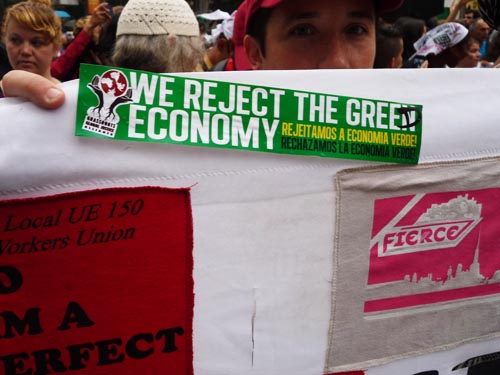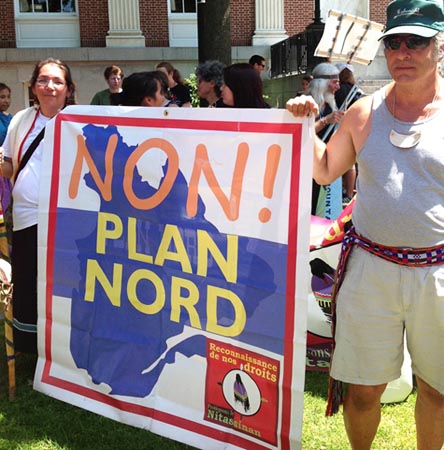
And it may seem reassuring. The cacophony of green policy-talk suggests an emerging consensus that we live in a unique era of tumultuous, interlocking crises. The globalized capitalist economy – made possible with cheap fossil fuels and a corporate culture of avarice– is collapsing while it devastates ecosystems and displaces land-dependent peoples. At the same time, the previously insulated middle-classes of the Global North are being confronted with unemployment or underemployment, mounting debts, a shattered housing market and extreme weather patterns establishing disaster as the new normal.
Those who are talking solutions fall into two groups: the green economy team, funded by multilateral financial institutions and government officials; and the human rights and justice team, a diverse yet formidable group comprised of global grassroots movements. The superficial consensus belies a fierce tug-of-war for our futures.
The danger is in the innocuous “green economy” which seems like the cure-all consensus. It falsely implies that the power brokers are taking action to mitigate and solve these crises. Despite the “green”, the policies continue a growth-model economy characterized by high consumption, inequality, and fossil fuel extraction on a finite planet already spinning out of control.
Over the course of this summer a series of conferences and summits epitomized the epic tug-of-war for our futures. In Vermont, the 36th Annual Conference of New England Governors and Eastern Canadian Premiers met in July, followed by the People’s Convention in August. One featured powerful officials negotiating the green-economy behind closed doors; the other drew rank-and-file activists and community members.
Vermont Governor Peter Shumlin hosted the Governor’s Conference to discuss energy, transportation and climate change among an invited list of politicians, government officials and other leaders. “When I see protestors suggest that we need to move toward renewables, we need to ensure that we get off oil and create jobs by promoting energy efficiency, I think you’ll find that we’re inside here doing the hard work to deliver on those wishes,” stated Shumlin at a press conference.

And this is where the green veil falls and the consensus disappears. As Hydro-Quebec generates more hydro-electricity for the grid, the Governors discussed the creation of a “green corridor” of electric car recharging stations from Quebec through the Northeastern United States. Facilitating high-tech ways to consume more electricity in closed-door meetings contradicts the calls of communities and organizations demanding equitable and democratic solutions.
At the People’s Convention for Human Rights, the following month in Vermont, participants of all stripes identified a “lack of democracy” as a root cause of various crises in our communities. Other causes included systems of oppression, individualism, and capitalism. The weekend culminated in a presentation of the Vermont Declaration of Human Rights, which highlights the human rights framework as the foundation of a visionary government that fulfills the fundamental needs of people without wreaking havoc on our planet.
The framework is a rubric for proposing solutions. A just system that meets the needs of people reflects a radically different way of making and evaluating decisions. And therein lies the rub. The elected officials at the Governors Conference still have meetings behind closed doors. Governors speak for the people, not with them. When one woman demanded her right to participate in decisions that affect her, her community and her children, she was denied.
The tug-of-war escalates on the international scene, where the differences are more pronounced, and the stakes are higher. At this summer’s United Nations Conference of Sustainable Development in Rio de Janeiro, Brazil, indigenous peoples and grassroots social movement organizations held separate and simultaneous conferences that underscored the irreconcilable differences between official international negotiations and their daily struggles.
In Rio, before official negotiations began, in an off-the-record press briefing it became clear that disagreement on Green Economy policies frustrated the United States’ interests in the talks. Many nations voiced concerns that the green economy will privatize and sell intact ecosystems, that it relies on non-binding commitments to reducing C02 emissions with offsets, and incentivizes “public-private partnerships” that will exacerbate debts among developing countries.
The final Outcomes Document affirms that “our determination to address the themes of the United Nations Conference on Sustainable Development, namely, a green economy…can only be achieved with a broad alliance of people, governments, civil society and the private sector, all working together to secure the future we want for present and future generations.”

The People’s Convention for Human Rights in Vermont joined the international People’s Summit and the Kari-Oca II in advocating the rights of people and nature as the solutions to the deepening crises affecting communities worldwide. They represent those who are in the trenches of the epic tug-of-war struggle for a future that cannot be determined in the closed-door meetings of experts. As stated in the Final Declaration of the People’s Summit, they fight for a future found “in our people, our history, our customs, knowledge, practices and systems of production.”
International financial institutions and corporations swindled the United Nations into wearing green as a camouflage for profit-making schemes as economies and ecosystems unravel. But really, the greens don’t match up. “The green economy is a crime against humanity and the Earth,” states the Kari-Oca II Declaration. And here, the differences become stark and the tug-of-war gets bitter. As stated in the People’s Summit final declaration, the people from Vermont to Brazil “denounce the true structural cause of the global crisis: the…capitalist system.” From this vantage point, it is clear: Money and life are not the same.
Avery Pittman works with Red Clover Climate Justice, a Northeast-focused environmental and social justice organization. This spring and summer, she traveled to Northern Quebec to meet Innu communities opposed to the Plan Nord, and then to Rio de Janeiro to report on the UN Conference on Sustainable Development and the concurrent People’s Summit.
